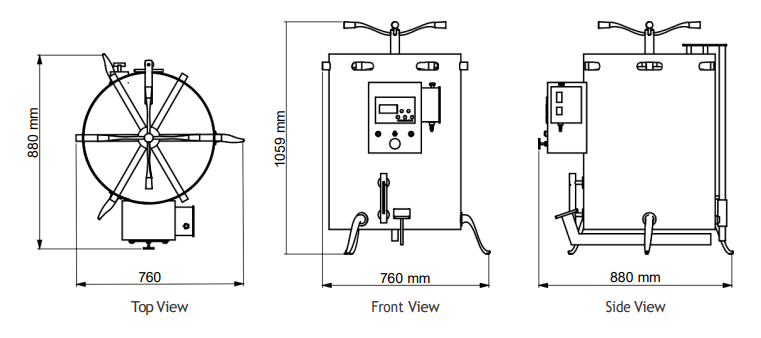

An autoclave is a machine used to sterilize equipment and materials with steam under high pressure. when water is heated inside the sealed chamber, the pressure rises and allows the temperature to get much hotter than normal boiling water. This high-temperature steam destroys bacteria, viruses, fungi, and even hardy spores.
Autoclaves are commonly used in hospitals, dental and medical clinics, laboratories, and research facilities—anywhere that absolutely clean, sterile tools are required. They’re valued for being reliable, powerful, and relatively low-cost compared to other sterilization methods.
The Auto-clave is thus indispensable for the maintenance of sterile conditions in microbiology, without which research and experiments cannot be conducted precisely. It is used to sterilize culture media, laboratory glassware, surgical instruments, pipette tips, and any other equipment coming into contact with microorganisms. Autoclaves in microbiology destroy all forms of microbial life, including the resistant bacterial spores; hence, they are the major implements in contamination prevention and in the generation of reliable experimental results.

Basically, the Autoclave principle applies steaming under pressure to get rid of the living organisms that could cause diseases.
Water's boiling point is increased above 100°C by high pressure in the chamber. Indeed, the temperature can reach as high as 121°C at 15 psi or pounds per square inch.
This high pressure allows heat to completely permeate the substances quickly and deeply, hence enabling proper sterilization to be achieved.
By far, the most lethal agent to microbial proteins is water vapor, which causes them to coagulate and denature.
However, when the steam comes into contact with cooler surfaces, condensation occurs, releasing latent heat at a rate of 518 calories per gram which helps in the transfer of heat.
Typically, an autoclave runs for 15 to 30 minutes at a fixed temperature and pressure (depending upon the what is in it and how dirty it is, whether the vessel contains liquid or dry goods).
Autoclaves run in three major cyclic phases:
The understanding of the autoclave diagram and its component members assists in good operation and maintenance.
Key parts include:

Presto Autoclave and Sterilizers come in several varieties, depending on the sterilization methods employed:
The usage of autoclaves ranges in various sectors:
The Presto Group autoclave is a significant equipment that is now a must-have in the current medical, scientific, and industrial fields. Based on the principle of autoclave moist heat sterilization under pressure, it achieves the destruction of all harmful microorganisms. You need to be familiar with the autoclave parts via an autoclave diagram, understand the proper use of the autoclave, and know which type of autoclave is suitable for your needs. There is a good selection of autoclaves to choose from, both basic and more sophisticated models, providing this essential technology for any size facility to help keep things sterile and avoid infections.
Looking for a trustworthy autoclave manufacturer with competitive price?
Contact our experts today to identify the best autoclave for your applications. Ring us at +91 9210 903 903 or send an e-mail at info@prestogroup.com to ask for a quotation and further information!
Related Blogs

Explore a complete lab equipment checklist with types, applications, and essential tools to ensure accurate testing and reliable lab performance.

Learn what a Colorimeter is, how it works, and its key parts, uses, and advantages in color measurement. Discover how this precision instrument ensures accurate color consistency across industries.

Melt Flow Index testing measures polymer flow under heat, ensuring quality, consistency, and compliance with ASTM/ISO standards for packaging, automotive, and plastics.